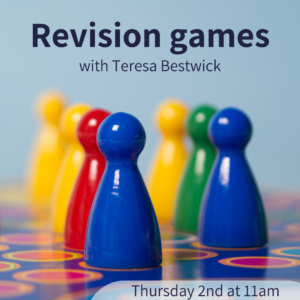Here are some easy-to-adapt activities for your classroom which can be used at any time of the year.
The Bomb Game
A fantastic game I picked up from a colleague, Matt Walker, many moons ago which is easy to play online and in the in-person classroom. Here’s a link to a blogpost about how to play if you want to make a set of cards. One of the benefits of playing a digital version is that you can have the questions written on the board – this is particularly useful if you want to use it for word transformation or gapfill activities where it would be better for learners to be able to read the sentence. As this is a team game, one other thing I mentioned in the webinar is about how to confer, as you don’t want to be sending learners into breakout rooms for each question if you’re playing on a video conferencing platform. A workaround could be to set up a Google doc for each team; in this way, they can chat to their group easily on a backchannel, as most videoconference chat will only allow you to message an individual or the whole class, not just a selected team within the group.
4 in a row
Another activity which can be adapted for just about anything is 4 in a row. It’s good to have three teams for this as it means learners have to have a bit of a strategy and there’s still a chance one team will win (having four teams makes it much easier to block other colours which takes away some of the fun of playing as it becomes obvious more quickly that nobody will actually win). In the example you can see in the link, I used it for a B2 level class practising word formation. However, I think it would be better for the learners to have more ‘authentic’ practice and have a sentence with the word in brackets but no clue as to what type of word fits the gap.
For young learners, you could have a grid of flashcards / images and have students make a sentence about the image to win that square. Alternatively, you could fill the grid with questions and students have to give a full answer to win the square. As I say, very versatile!

8 Way Thinking
Next up is an idea stolen from Anne Robinson who has a fabulous blog with lots of ideas covering different ages and skills. This is less of a revision activity, but I wanted to include it as I know sometimes our students who are preparing for exams with picture descriptions can get a bit bored of just describing what they can see and this activity gets them being a bit creative, using their critical thinking skills and practises question formation.
The idea is that students write three questions for each of the eight ways of thinking about the picture. They could write one question for each way and then compare in groups of three; or they could write three questions for two ways and compare in groups of four – lots of ways to practise writing questions!
Devil’s Advocate
Another idea I’ve pinched is Jim Fuller’s Devil’s Advocate, which is an easy filler to revise the typical functional language of discussions learners are often expected to demonstarte in exams: asking for and giving an opinion, agreeing and disagreeing, interrupting, rephrasing, summarising and so on.
This is another activity that gets students using their critical thinking skills as they may have to argue a point that they personally disagree with.
Some topics which could be used for discussion include:
- Cats are better than dogs.
- Netflix is better than HBO Max.
- TikTok is better than Instagram.
Also, if you haven’t checked out Jim’s Sponge Chats, I highly recommend giving them a watch and his blog is also full of really interesting posts about teaching and training.
Retrieval Grids
Another prolific blogger and all-round awesome ELT professional is Pete Clements and I nabbed this next idea from one of his recent blogposts (and he in turn got the idea when reviewing a book on his blog).
For this activity, you’ll need to draw a grid and give students two dice (or use an online dice spinner, thanks to Stephanie for posting a link to this one during the webinar). Students roll the two dice twice to get the coordinates of two words, which they then have to combine in a sentence.
Again, easily adaptable for all sorts of different vocabulary. For example, with younger learners you could fill the grid with animals, body parts and actions or with furniture, parts of the house and actions.
Jeopardy
This is a great website where you can easily create game boards with different topics and questions worth different amounts of points. You could get students to write their own questions about different topics, use it to review phrasal verbs, word formation activities – anything goes!
Dice Games
On my blog, there are a number of dice games to download to review everyday personal information questions.
Battleships
There’s also a post about vocabulary battleships, which is a fun game to review emergent language and could also be used for topic vocabulary.
Last thoughts…
A couple of fun sites which I wanted to mention as well: autodraw is really handy for adding simple clipart to your digital worksheets and presentations if you’re not particularly artistic. And when I was trying to remember the autodraw site, I came across quickdraw which is a really fun pictionary game you play against AI – one to recommend for your learners to try outside the classroom. And, on the topic of fun, I mentioned Sarah Priestley’s Innovate plenary from a few years ago, which I think is always worth re-reading.

1 thought on “Revision Games”